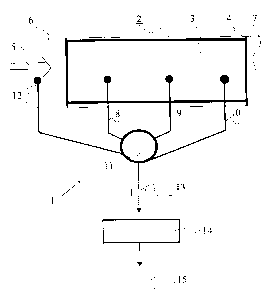Some of the information on this Web page has been provided by external sources. The Government of Canada is not responsible for the accuracy, reliability or currency of the information supplied by external sources. Users wishing to rely upon this information should consult directly with the source of the information. Content provided by external sources is not subject to official languages, privacy and accessibility requirements.
Any discrepancies in the text and image of the Claims and Abstract are due to differing posting times. Text of the Claims and Abstract are posted:
| (12) Patent: | (11) CA 2279655 |
|---|---|
| (54) English Title: | DEVICE AND METHOD FOR INDICATING EXHAUSTION OF A FILTER |
| (54) French Title: | DISPOSITIF ET METHODE D'INDICATION D'USURE D'UN FILTRE |
| Status: | Term Expired - Post Grant Beyond Limit |
| (51) International Patent Classification (IPC): |
|
|---|---|
| (72) Inventors : |
|
| (73) Owners : |
|
| (71) Applicants : |
|
| (74) Agent: | SMART & BIGGAR LP |
| (74) Associate agent: | |
| (45) Issued: | 2004-02-10 |
| (22) Filed Date: | 1999-08-06 |
| (41) Open to Public Inspection: | 2000-06-23 |
| Examination requested: | 1999-08-06 |
| Availability of licence: | N/A |
| Dedicated to the Public: | N/A |
| (25) Language of filing: | English |
| Patent Cooperation Treaty (PCT): | No |
|---|
| (30) Application Priority Data: | ||||||
|---|---|---|---|---|---|---|
|
A device for indicating exhaustion of a gas filter that is filled with an adsorbing agent (3) is described, said device incorporating a hazardous-gas detector (14) that detects a hazardous gas content at a sampling point (8) within the adsorbing agent (3). The device according to the present invention is characterized by a reference sampling point (12) that is located in the vicinity of a gas-entry point (6) of the gas filter (2), the hazardous gas detector being so designed that it determines the hazardous-gas content at each sampling point (8, 12) in turn, and determines filter exhaustion by comparison of the hazardous gas content at the sampling point (8) with the hazardous-gas content at the reference sampling point (12).
Dispositif d'indication de l'usure d'un filtre à gaz rempli d'un agent adsorbant (3), ledit dispositif incorporant un détecteur de gaz dangereux (14) qui détecte un contenu en gaz dangereux à un point d'échantillonnage (8) dans l'agent adsorbant (3). Le dispositif selon la présente invention est caractérisé par un point d'échantillonnage de référence (12) situé à proximité d'un point d'entrée de gaz (6) du filtre à gaz (2), le détecteur de gaz dangereux étant désigné de sorte à déterminer le contenu en gaz dangereux à chaque point d'échantillonnage (8, 12) à son tour, et détermine l'usure du filtre par comparaison du contenu en gaz dangereux au point d'échantillonnage (8) avec le contenu en gaz dangereux au niveau du point de référence d'échantillonnage (12).
Note: Claims are shown in the official language in which they were submitted.
Note: Descriptions are shown in the official language in which they were submitted.

2024-08-01:As part of the Next Generation Patents (NGP) transition, the Canadian Patents Database (CPD) now contains a more detailed Event History, which replicates the Event Log of our new back-office solution.
Please note that "Inactive:" events refers to events no longer in use in our new back-office solution.
For a clearer understanding of the status of the application/patent presented on this page, the site Disclaimer , as well as the definitions for Patent , Event History , Maintenance Fee and Payment History should be consulted.
| Description | Date |
|---|---|
| Inactive: Expired (new Act pat) | 2019-08-06 |
| Change of Address or Method of Correspondence Request Received | 2018-03-28 |
| Inactive: IPC from MCD | 2006-03-12 |
| Inactive: IPC from MCD | 2006-03-12 |
| Inactive: IPC from MCD | 2006-03-12 |
| Grant by Issuance | 2004-02-10 |
| Inactive: Cover page published | 2004-02-09 |
| Pre-grant | 2003-12-01 |
| Inactive: Final fee received | 2003-12-01 |
| Notice of Allowance is Issued | 2003-11-07 |
| Letter Sent | 2003-11-07 |
| Notice of Allowance is Issued | 2003-11-07 |
| Inactive: Approved for allowance (AFA) | 2003-10-20 |
| Amendment Received - Voluntary Amendment | 2002-09-17 |
| Inactive: S.30(2) Rules - Examiner requisition | 2002-04-08 |
| Amendment Received - Voluntary Amendment | 2002-02-28 |
| Inactive: S.30(2) Rules - Examiner requisition | 2001-10-03 |
| Inactive: Cover page published | 2000-07-12 |
| Application Published (Open to Public Inspection) | 2000-06-23 |
| Inactive: Cover page published | 2000-06-22 |
| Letter Sent | 1999-11-03 |
| Inactive: Single transfer | 1999-10-13 |
| Inactive: IPC assigned | 1999-09-27 |
| Inactive: First IPC assigned | 1999-09-27 |
| Inactive: Courtesy letter - Evidence | 1999-09-14 |
| Inactive: Filing certificate - RFE (English) | 1999-09-09 |
| Application Received - Regular National | 1999-09-09 |
| Request for Examination Requirements Determined Compliant | 1999-08-06 |
| All Requirements for Examination Determined Compliant | 1999-08-06 |
There is no abandonment history.
The last payment was received on 2003-07-24
Note : If the full payment has not been received on or before the date indicated, a further fee may be required which may be one of the following
Patent fees are adjusted on the 1st of January every year. The amounts above are the current amounts if received by December 31 of the current year.
Please refer to the CIPO
Patent Fees
web page to see all current fee amounts.
Note: Records showing the ownership history in alphabetical order.
| Current Owners on Record |
|---|
| DRAGER SICHERHEITSTECHNIK GMBH |
| Past Owners on Record |
|---|
| KLAUS AMMANN |
| MICHAEL DIETRICH |
| WOLFGANG BATHER |